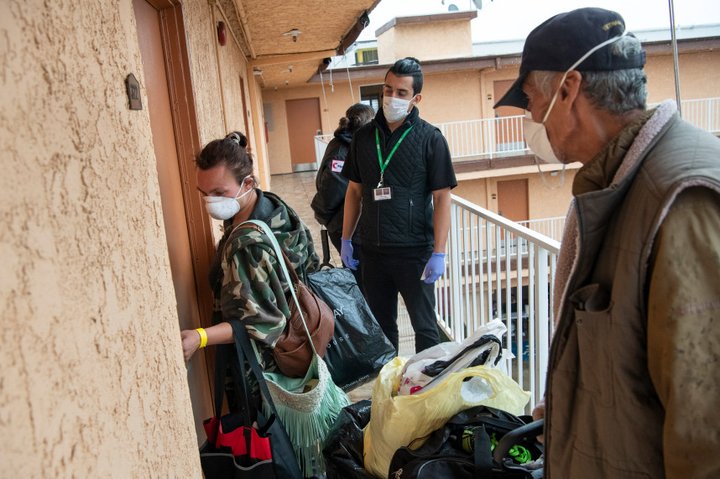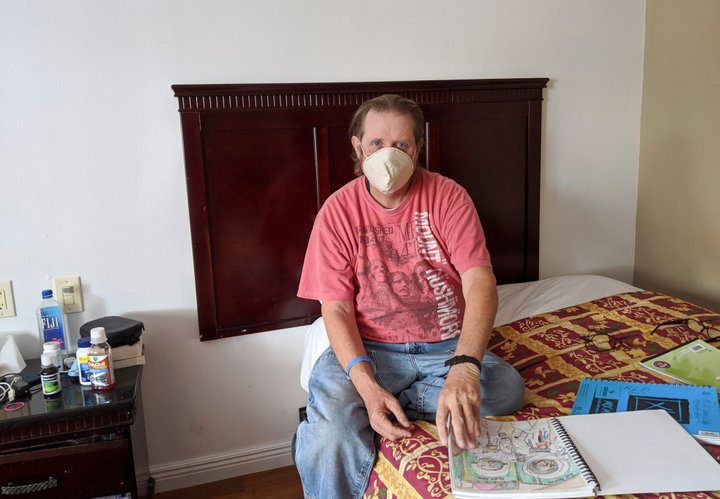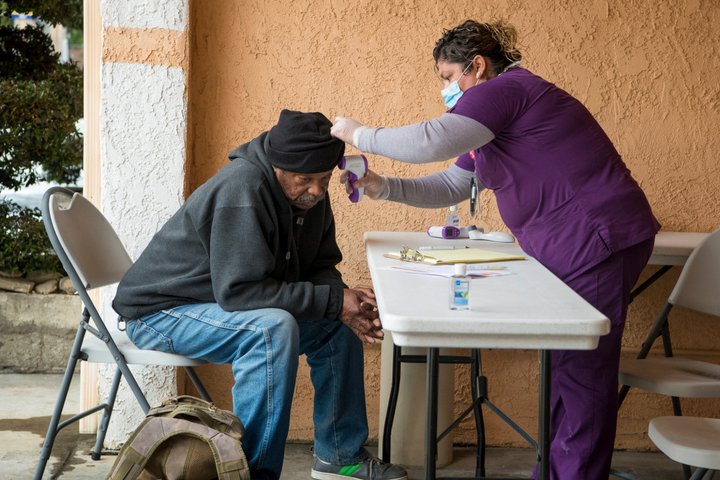
Cassie Gamboa, left, and Robert Romo, right, go into their new hotel room with Edwin Aviles, of Union Station Homeless Services on Tuesday, April 7, 2020. Photoby Michael Owen Baker courtesy of Los Angeles County
###
Richard Dobbs was coughing, feverish, and preparing to sleep on the sidewalk again.
Dobbs, 60 and homeless in Sacramento for the past two years, had just been discharged March 28 from Sutter Medical Center’s emergency department, where he was given a test for COVID-19, the disease caused by the new coronavirus, and written instructions for how to self-isolate while he awaited the results.
“Separate yourself from other people in your home,” read a bold-faced warning. “Stay home except to get medical care,” read another.
Home for Dobbs most nights was the sidewalk next to the Wells Fargo Pavillon, a theater in downtown Sacramento. Staff at a local food bank saw him in line the next day and scrambled to find him a motel room where he could safely self-quarantine.
Dobbs’ test results came back negative. But with his motel stay scheduled to end on Monday and county caseworkers trying to place him in transitional housing, Dobbs is fearful he’s now even more vulnerable to the virus.
“I would stay (in the motel) for a while now because I’ve always hated going into shelters,” said Dobbs. “Because you get sick going into those places.”
In an unprecedented effort spurred by the pandemic, Gov. Gavin Newsom and local governments across the state say they are scrambling to find 15,000 hotel rooms for people like Dobbs: homeless and particularly susceptible to or exhibiting symptoms of coronavirus infection.

Richard Dobbs in his Sacramento motel room. Photo courtesy of Ginny Bayly, Loaves and Fishes
As homeless Californians begin to move into these units, new questions have arisen for hoteliers, shelter providers, health care workers and government officials: How much should a room cost, and who should pay for it? How will meals be delivered? How will residents with mental health and addiction issues be handled?
And, when all this ends, will people in these rooms end up back on the street?
Here are some answers:
How many homeless people have been moved into hotels so far, and how many rooms are available?
The data here is sketchy. A spokesperson from Newsom’s office said today 1,813 hotels or motel rooms are now occupied as part of Project Roomkey, a joint effort between the state, counties and the Federal Emergency Management Agency. Newsom also said during a press conference that the state had helped procure 8,742 rooms.
State and local housing officials say Newsom’s numbers are underestimates because they don’t capture independent efforts from county governments to set up hotel rooms on their own. San Diego County, praised by Newsom for its quick action, secured 1,300 rooms in mid-March. The number of people actually relocated to hotel rooms is also due to increase significantly this week. Los Angeles County alone plans to have more than 1,069 beds occupied by the end of the week.
But the task ahead is daunting. More than 150,000 people are homeless in California, 108,000 unsheltered; an optimistic count of the number of those moved to hotel rooms so far represents a little over 1% of that total. The effort has already required a great deal of logistical gymnastics and staffing. Even focusing on only the highest-risks populations — seniors, those with underlying health conditions — will be a huge undertaking.
Where are the hotels? And are we talking about the Ritz or Motel 6?
State and local health officials have declined to share a comprehensive listing of hotels that have opened their doors to homeless people. They argue releasing such information risks those individuals homeless showing up at hotels and demanding rooms without referrals from physicians or caseworkers.
More than 1,000 hotels across the state have at least expressed an interest in providing emergency quarantine accommodations, although that includes temporary housing for health care workers and first responders, according to data from the California Hotel & Lodging Association. Hotels in Los Angeles, San Diego and Orange counties alone account for more than 40% of possible rooms in that survey.
While some higher-end boutiques and well-known brands such as Comfort Inn and Radisson are participating, state and county officials are having more success with smaller, independent motels that may already have relationships with local housing authorities.
That’s partly because independent motel owners can act quicker than major corporate chains, and partly because those motels are often already located in neighborhoods with shelters and other homeless service providers, making it easier for counties to get them up and running.
Are enough hotels willing to do this?
Yes, at least so far.
Local health and homelessness officials will tell you finding hotels and motels willing to participate hasn’t been a major bottleneck yet. At least not compared to other logistical hold-ups (see below).
“We have a lot of interest, a lot of receptiveness, from motel operators,” said Cynthia Cavanaugh, director of homeless initiatives for Sacramento County. “We actually have interest from places we never expected, so that part has not been as much of a challenge.”
The major reason hotels and motels are opening their doors so readily is the obvious one: It’s not like demand for hotel rooms is high right now.
“(These are) brutal, unprecedented, extraordinary times,” said Lynn Mohrfeld, president of the California Hotel and Lodging Association. “Anyone that is open right now is losing money,”
Mohrfeld said on a typical non-pandemic week, about 70% of hotel rooms across the state are occupied. Now it’s single digits.
Who is paying for the hotels, how much are they paying, and what about insurance?
Newsom said late last week that the Federal Emergency Management Agency will pick up 75% of the tab for rooms that are housing homeless people who have tested positive, are symptomatic, have been exposed to the virus, or are in highly vulnerable populations. Counties are on the hook for the rest, as well as for services, such as case managers and counselors, that residents may need. Counties can tap state emergency funds to help pay.
So far, the state has distributed $150 million to counties to help pay for motels and other homelessness services, but the total cost borne to taxpayers will undoubtedly be more.
Lease costs vary from county to county and hotel to hotel. But Mohrfeld said room rates in general are at least in shouting distance of the rates the federal government pays when its employees stay in California hotels. That “standard” rate is about $96 per room per night (higher in most cities), and leases are typically 60 to 90 days with options for extensions. Hotels may also be receiving additional reimbursement for higher insurance rates and associated costs.
While local governments and the state have generally agreed in contracts to pay for any property damage incurred as a result of repurposing hotel room, Mohrfeld said there’s still uncertainty among some hotel owners that their properties will be returned to them in the condition they were in before the quarantine.
“It’s the fear of the unknown,” said Mohrfeld.
Who gets into these hotels?
First priority for state and county health officials are homeless Californians who have tested positive or are experiencing symptoms of COVID-19.
While the process varies from county to county, the general timeline is as follows: Shelter staff identify someone with symptoms and quarantine them within the shelter as quickly as possible. The shelter staff then alert county health and homelesnsess staff that the individual is in need of a motel room where they can self-isolate. That person is then safely transported to an “isolation” motel where an on-site nurse and other medical staff monitor their health. Once the person is free of symptoms and believed not to be contagious anymore, they are discharged back into a shelter or into another housing option, if available.
If their condition worsens, they may be taken to a hospital. These “isolation” motels may include not only people who are homeless, but others who are symptomatic or have tested positive but lack a safe place to self-quarantine (those in senior homes, for example).
Multiple shelters across the state have already reported residents with positive tests, and officials are hoping to avoid outbreaks in congregate shelters. Removing symptomatic patients can also free up more beds for healthy people to come in off the streets. But some advocates still warn that congregate settings and resident turnover puts healthy people at risk of contracting the virus.
Those identified as symptomatic on the street will also be eligible for the hotels.
What about the homeless who don’t have the virus or aren’t symptomatic?
Homeless Californians over 65 or with underlying health conditions will be placed in their own motel rooms, separate from those who have tested positive or are symptomatic. It’s unclear how long this population will be allowed to stay in their rooms, and may vary from county to county.
In recent comments, Newsom has pushed back against any expectation that the state may be able to provide motels for every Californian living on the streets. The hope is that by rapidly expanding emergency shelters (San Diego has converted its convention center to a shelter; Los Angeles has converted city recreation centers), homeless individuals that don’t fit the “high-priority” populations eligible for hotels will still be able to come indoors.
But some homelessness advocates have decried that approach, insisting that hotel rooms be commandeered for anyone without shelter in the midst of a pandemic. A plan to convert San Francisco’s Moscone Center into a temporary shelter has been scaled back after photos emerged of a conference center packed with thin sleeping mats, folding chairs and not much else.
BREAKING: Mayor Breed Opts for Mass Indoor Camps: A look inside the Moscone Center congregate “shelter”#Covid_19 #homelessness #SanFrancisco #HouseUsNow #Housing4All #shelteringinplacehttps://t.co/sL8p5RGdcc pic.twitter.com/W3TLhH3dei
— Street Sheet (@StreetSheetSF) April 6, 2020
Why the delay between acquiring rooms and getting people inside?
On March 16, Newsom said the state had helped acquire its first two hotels for emergency homeless housing, by the Oakland Airport in Alameda County. But the ink on the lease had been dry for nearly two weeks before people who were homeless actually started to move in. Why the delay?
Staffing. Arranging physicians, nurses, caseworkers, food delivery, security, cleaning and other services has been more of a hurdle than actually acquiring the hotels. For hotels isolating those who are symptomatic, personal protective equipment is needed for county, nonprofit and hotel staff.
Transportation has also proved a challenging issue as counties grapple with how to safely move symptomatic homeless people with pets and belongings while protecting transit workers.
“Our population is not just getting on a bus with a suitcase,” said Cavanaugh. “The need to have specialized transportation to handle all of those things is large.”
Who is working at the hotels?
Staffing will vary from hotel to hotel and county to county, and will depend on whether hotels are intended for isolating homeless people suspected of having the virus or simply vulnerable because of age or underlying health conditions.
The Mayfair Hotel in downtown Los Angeles has 23 people who have COVID-19 symptoms or have tested positive, including several who are homeless. Eventually, the goal is to have 284 of the hotel’s 300 rooms occupied with people who are self-isolating.
There’s a nurse on site 24 hours a day. Physicians conduct telephone and video check-ins with residents. Private security monitors each floor, and private cleaning crews in personal protective equipment clean rooms when needed.

CNA Yesenia Chavez checks the temperature of Grehlin Wright who was registering for a hotel room through Project Roomkey in LA County on April 7, 2020. Photo by Michael Owen Baker courtesy of Los Angeles County
Either Stephen Fiechter or someone else from PATH, a nonprofit homeless service provider, is there all day to check-in with homeless residents on the phone, drop off meals at their door, and connect residents with shelter and other housing options once their stay is over.
Fiechter said that while organizations like PATH are happy to assist with the motel initiative, it’s been difficult to maintain their other homeless operations at the same time, which include operating shelters.
“It’s the staffing piece that’s really challenging,” said Feitcher. “Bringing on experienced folks, but not stripping our other programs.”
While not the case at the Mayfair, hotel staff may also be deputized to assist in cleaning up rooms or common spaces.
Mohrfeld, head of the statewide California hotel association, said that while some custodial workers may be hesitant to help, others are eager for the work and feel a sense of civil mission.
“Some are okay with it, some are fearful — it kind of runs the gamut,” said Mohrfeld, who said some hotels are negotiating with counties to ensure their staff receive protective gear.
What happens after the virus threat subsides?
While hotel owners, state and local officials, and homelessness advocates are understandably focused on the public health crisis at hand, the question of what will happen to the homeless after the virus threat subsides lingers.
Newsom has said many of the leases the state is negotiating include an option to purchase the entire property for more permanent housing, But Mohrfeld said that most hotels and motels he’s been in contact with haven’t agreed to such options.
While the optics of eventually forcing homeless people out of a hotel room may be a public relations nightmare, Mohrfeld said he’s more concerned with possible future litigation from advocates preventing such action if better housing options don’t materialize.
“What happens when they don’t have anywhere to go and… (advocates) sue the state and say they can’t move them and then the state’s hands are tied?” said Mohrfeld. “The litigation aspect concerns me a lot.”
Homeless service providers are still trying to connect residents in shelters, motel rooms, and on the street to more permanent housing solutions.
“None of this is stopping our attention from what really resolves homelessness, and we think we will have an opportunity to move folks into permanent housing,” said Emily Halcon, homelessness services coordinator with the city of Sacramento.
What about neighbors of these hotels?
How do neighbors feel about nearby hotels housing dozens of homeless people, some with COVID-19 symptoms? In Orange County, a senior community next to a 138-bed hotel slated to house the homeless protested the arrangement until the county agreed to find another site.
But other than that high-profile example, Mohrfeld said complaints from neighbors have been relatively rare and haven’t interfered much with motels agreeing to leases.
###
CALmatters.org is a nonprofit, nonpartisan media venture explaining California policies and politics.
CLICK TO MANAGE